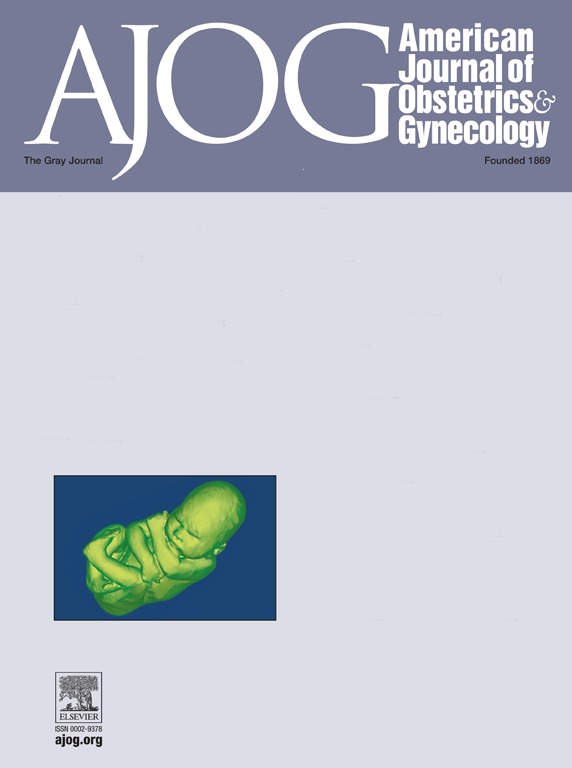有证据表明,全身血管阻力在妊娠糖尿病发生之前就已经增加。
IF 8.4
1区 医学
Q1 OBSTETRICS & GYNECOLOGY
引用次数: 0
摘要
背景:眼动脉是颈内动脉的第一分支,其多普勒速度波形有两个收缩峰。第二波收缩峰值速度(PSV)除以第一波的比值反映了外周阻力的增加。以往对妊娠第一、第二和第三孕期的研究报告显示,在随后出现子痫前期(PE)的孕妇中,PSV 比值会升高。子痫前期(PE)和妊娠糖尿病(GDM)都与内皮功能障碍和妊娠后头十年心血管疾病风险增加有关:比较妊娠11-13周时罹患GDM的孕妇与未受影响的孕妇以及罹患PE的孕妇的眼动脉PSV比值:这是一项前瞻性观察研究,对象是在妊娠 11+0 - 13+6 周到英国伦敦国王学院医院进行常规医院就诊的妇女。此次就诊包括记录产妇人口特征和病史、胎儿解剖和生长超声检查、评估产妇眼动脉血流速度波形和计算 PSV 比值,以及测量平均动脉压 (MAP)。根据母体特征和 MAP 对眼动脉 PSV 比率进行线性回归预测。将 GDM 组的 PSV 比率与 PE 组和未受影响妊娠组的 PSV 比率进行比较:研究共纳入 3999 名妇女,其中 375 人(9.8%)罹患 GDM,101 人(2.5%)罹患 PE。在 GDM 组中,161 人(43.3%)接受了单纯饮食治疗,130 人(34.1%)接受了二甲双胍治疗,84 人(22.6%)接受了胰岛素和二甲双胍治疗。PE的发生、产妇年龄、体重指数、MAP、一级糖尿病家族史、PE家族史、亚裔和吸烟对PSV比率有显著的预测作用。GDM 的影响不大。在发生需要胰岛素治疗的 GDM 的妇女中,眼动脉 PSV 比值(0.67 ± 0.09)较高(P 结论):在发生严重 GDM 并需要胰岛素治疗的妇女中,有证据表明外周阻力增加,这在妊娠第一个妊娠期就很明显。本文章由计算机程序翻译,如有差异,请以英文原文为准。
Evidence that systemic vascular resistance is increased before the development of gestational diabetes mellitus
Background
The ophthalmic artery, which is the first branch of the internal carotid artery, has a Doppler velocity waveform with 2 systolic peaks. The ratio of the peak systolic velocity of the second wave divided by that of the first wave is used to reflect increased peripheral resistance. Previous studies in the first, second, and third trimesters of pregnancy have reported that in pregnant women who subsequently develop preeclampsia, the peak systolic velocity ratio is increased. Both preeclampsia and gestational diabetes mellitus are associated with endothelial dysfunction and an increased risk for cardiovascular diseases during the first decade after pregnancy.
Objective
This study aimed to compare the ophthalmic artery peak systolic velocity ratio at 11 to 13 weeks’ gestation of women who subsequently develop gestational diabetes mellitus with that of unaffected pregnant women and those who develop preeclampsia.
Study Design
This was a prospective observational study of women who attended the King’s College Hospital, London, United Kingdom, for a routine hospital visit at 11+0 to 13+6 weeks’ gestation. This visit included recording of the maternal demographic characteristics and medical history, an ultrasound examination for fetal anatomy and growth, assessment of the flow velocity waveforms from the maternal ophthalmic arteries, calculation of the peak systolic velocity ratio, and measurement of the mean arterial pressure. Linear regression was performed to predict the ophthalmic artery peak systolic velocity ratio based on maternal characteristics and the mean arterial pressure. The peak systolic velocity ratio in the group with gestational diabetes mellitus was compared with that of preeclamptic and unaffected pregnancies.
Results
A total of 3999 women were included in this study, including 375 (9.8%) who developed gestational diabetes mellitus and 101 (2.5%) who developed preeclampsia. In the gestational diabetes mellitus group, 161 (43.3%) were treated by diet alone, 130 (34.1%) were treated with metformin, and 84 (22.6%) received insulin with or without metformin. Prediction of peak systolic velocity ratio was provided by development of preeclampsia, maternal age, body mass index, mean arterial pressure, first-degree family history of diabetes mellitus, family history of preeclampsia, Asian ethnicity, and smoking. There was no significant contribution from gestational diabetes mellitus. Among women who developed gestational diabetes mellitus that required insulin treatment, the ophthalmic artery peak systolic velocity ratio (0.67±0.09) was higher (P<.001) than that in unaffected pregnancies (0.63±0.10), but it was not significantly different from that in the preeclampsia group (0.69±0.10; P=.90).
Conclusion
Among women who developed severe gestational diabetes mellitus that required insulin treatment, there was evidence of increased peripheral resistance, which was apparent from the first trimester of pregnancy.
求助全文
通过发布文献求助,成功后即可免费获取论文全文。
去求助
来源期刊
CiteScore
15.90
自引率
7.10%
发文量
2237
审稿时长
47 days
期刊介绍:
The American Journal of Obstetrics and Gynecology, known as "The Gray Journal," covers the entire spectrum of Obstetrics and Gynecology. It aims to publish original research (clinical and translational), reviews, opinions, video clips, podcasts, and interviews that contribute to understanding health and disease and have the potential to impact the practice of women's healthcare.
Focus Areas:
Diagnosis, Treatment, Prediction, and Prevention: The journal focuses on research related to the diagnosis, treatment, prediction, and prevention of obstetrical and gynecological disorders.
Biology of Reproduction: AJOG publishes work on the biology of reproduction, including studies on reproductive physiology and mechanisms of obstetrical and gynecological diseases.
Content Types:
Original Research: Clinical and translational research articles.
Reviews: Comprehensive reviews providing insights into various aspects of obstetrics and gynecology.
Opinions: Perspectives and opinions on important topics in the field.
Multimedia Content: Video clips, podcasts, and interviews.
Peer Review Process:
All submissions undergo a rigorous peer review process to ensure quality and relevance to the field of obstetrics and gynecology.

 求助内容:
求助内容: 应助结果提醒方式:
应助结果提醒方式:


